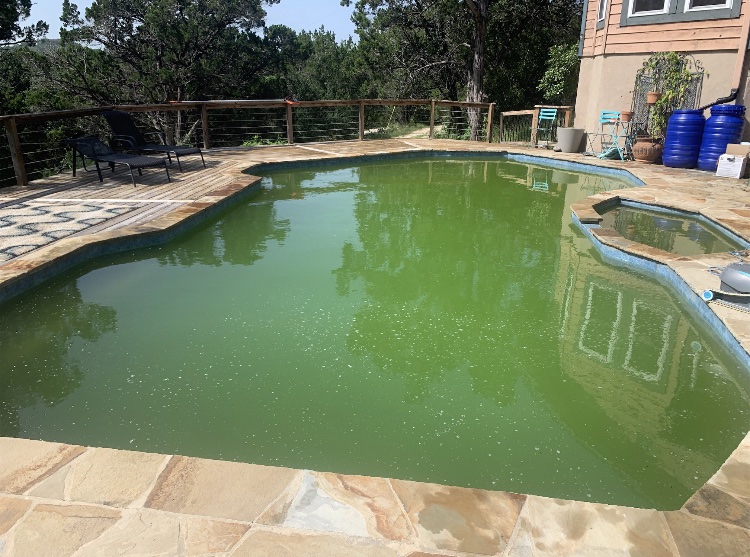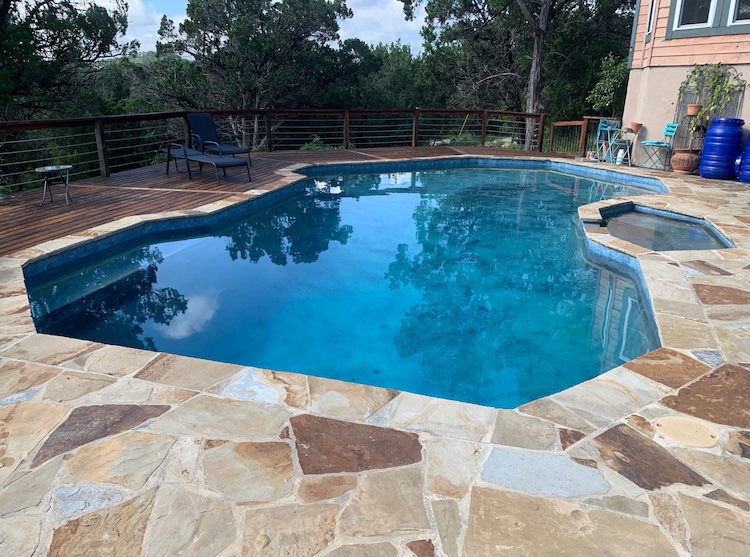How to Get Rid of Algae in Your Pool
Go from Green to Clean in 13 Easy Steps; #5 Kind of Sucks!

If the water in your pool has ever become green, then you know how yucky that can appear. Is it unsightly? Yes. Is it a nuisance? Sure is. Is it dangerous to humans? Generally speaking, the green algae itself is not harmful to people, but the bacteria that feeds upon it can create certain health issues.
First of all, that bacteria can cause skin conditions, such as rashes and breaks in the skin. Secondly, since algae can be quite slippery, it can cause you to lose your footing in the pool. This could lead to bumps, bruises, and maybe even a broken bone. Thirdly, a pool with algae is a cloudy pool, which inhibits visibility. If someone was struggling to swim, that individual might not be as easy to see as they would be under clear water conditions.
So, what does it take to kill algae in your swimming pool and keep it from returning?
How to Get Rid of Algae in your Pool



Sometimes no matter how hard we try, algae can be quite mischievous. We do everything in our power to keep it at bay, but somehow those tiny little annoying spores continue to rear their ugly little heads, hampering our efforts to keep the water clean, clear, and healthy on a consistent basis.
When your pool is green with algae, you have a problem that requires a solution, so let’s get down to it. Getting the job done is not brain surgery, but it does take a bit of effort on your part. However, when you know what you are doing – and you have the proper tools for attack – then you will be an algae-destroying superhero in no time.
- Test and balance the water chemistry. This means you must test the chlorine and pH levels, ensuring to bring that pH level to roughly 7.8. Also, be sure the chlorine is at least 1 ppm.
- Fire up the pump. When you are treating your pool, your pump has to work overtime. That means a 24-hour day. This prevents further algae growth by not allowing the water to stagnate.
- Get rid of debris. It is time to roll up your sleeves and get some cleaning done now. Go all in and remove as much as you can: leaves, algae, and other contaminants. Use a net, scoop with a bucket, or contact your local Ultra Pool Care Squad expert to get the job done. (Really! We can do all this work for you. In fact, just give us a call. You can stop reading now and we will do the rest!)
- Brush up on brushing duties. Scrub-a-dub-dub. It’s time to put some muscle into the cleaning here. Scrub every surface from top to bottom…and scrub again if you think you have to. The ultimate of clean is the goal here. And don’t put that brush away just yet. You are going to need it again in a bit. Just keep reading.
- Suck it up. Break out the pool vacuum and clean the surface as much as you can. Vacuum up any debris left by all that scrubbing you just did.
- Clean those filters. If your pool filters are not clean, they cannot effectively get rid of the algae. Clean them out and rinse them off!
- Prepare for the shock of your life. (Well, not really, but at least prepare for the shock of the pool.) Now it is time to properly shock your pool. Yes, we know…you should be doing this on a weekly basis already, but if algae have taken up what appears to be a push for permanent residence, now is the time to bring in the reinforcements. When you are shocking your pool, you are essentially super-chlorinating it. What shouldn’t be living in the water will soon be packing their bags and moving out. Note: if the algae are black instead of green, expect to shock it a bit more. After you shock your pool (and be sure to follow the manufacturer’s directions for the shock you are using in relation to the size of your pool), the water may still look cloudy for a day or two. Give the filter time to clean it all up, which can take about a day or two. Also, don’t let anyone back in the water until the chlorine level reads less than 3 ppm.
- Brush your pool. (What? Again?) We told you that brush was not done yet. You will need it in the following steps to fully get rid of all algae blooms.
- Floc your pool. (No, don’t flock to your pool; floc your pool.) This step will remove any of those small pores that were not destroyed in the earlier steps. You do not want to skip this step if you have hard-to-remove black algae. This is where the rubber meets the road, or rather the floc meets the algae.
- Vacuum….again. Vacuum the sides and bottom of the pool now. This helps get more algae out.
- Filter time again. Your filters will need further cleaning now, as most likely debris and more algae blooms found their way to it. Clean and backwash if needed to keep any of those nasty buggers from recirculating back into the pool.
- Bring on the algaecide. Not only will this remove existing algae, but it will help to prevent future algae growth.
- Test the water chemistry. A normal chlorine level reading is 1-3 ppm. Normal pH levels should be between 7.4 and 7.6. If it is at 7.5, that is the ideal level for algae annihilation! As for alkalinity, make sure that reads between 80-140 ppm.
How to Keep Algae from Returning to Your Pool
Now that you have completed the necessary steps for removing algae from your swimming pool, here are some more action steps to take to ensure algae doesn’t return. (Basically, you are doing what we directed above, but on a regular basis. It’s kind of like taking care of your car. If you keep it properly maintained, you reduce the risk of having problems.)
- Mind the pump. Algae thrives in stagnant water. Therefore, it is critical to keep your pool’s pump in prime working condition. If it gets clogged or simply under-performs, that is an open invitation for algae to come on in. Clean the pump strainers and skimmers at least a couple of times a week.
- Shock the pool. Get into the habit of doing this once a week. Your efforts will pay off.
- Brush the pool. Do this regularly. If you have a fiberglass pool, however, you will want to use a nylon brush, so you don’t scratch the surface of the pool. A concrete pool can withstand a wire brush.
- Keep up with the chemistry. Regularly checking the chemistry of your pool will pay off in spades. Algae spores cannot bloom in well-balanced pool water.
- Vacuum, vacuum, vacuum. This is a necessary evil and must be done routinely if you want those algae spurs to keep their distance.
- Stock up on the algaecide. If you want to keep your pool free of algae, regular use of this stuff will do the trick.
Want Expert Help?
No problem! At Ultra Pool Care Squad, we are here to serve. We do not retreat in the face of algae (or any other pool culprit that will harm the integrity and health of your pool’s water.) If you need help with getting rid of algae and keeping it away, or if you simply have any other repair/cleaning/maintenance questions about your backyard swimming pool, give us a call at 855-85-CLEAN. You can also visit us online at ultrapoolcaresquad.com and submit any questions to us.
See you by the pool!